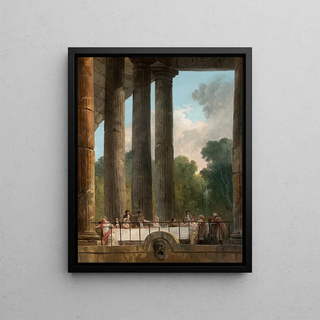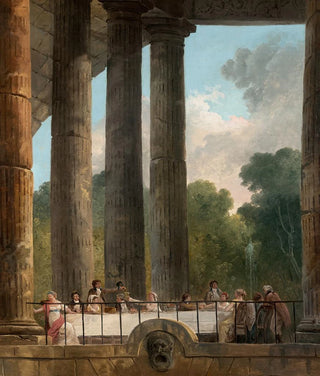Art print | A banquet in the ruins of a temple - Hubert Robert


View from behind

Frame (optional)
In the vibrant universe of 18th-century art, Hubert Robert's "A Banquet in the Ruins of a Temple" stands as a true ode to the beauty of decay. This painting, imbued with nostalgia and romanticism, transports us to a world where nature reclaims its rights over the remnants of a vanished civilization. The majestic ruins, wrapped in greenery, evoke an atmosphere that is both melancholic and serene. Through this scene, Robert invites us to reflect on the passage of time and the fragility of human existence, while celebrating the splendor of landscapes. The composition, rich in detail and nuance, captures the eye and the imagination, immersing us in timeless reverie.
Style and uniqueness of the work
Hubert Robert's work is distinguished by his ability to blend the sublime and the sublime. In "A Banquet in the Ruins of a Temple," the painter skillfully plays with light and shadow, creating striking contrasts that enhance the depth of the scene. The human figures, though present, seem almost secondary compared to the imposing architecture that surrounds them. This visual hierarchy emphasizes the idea that man, despite his grandeur, is merely an intruder in a world governed by much more powerful forces. The colors, warm and vibrant, evoke an inviting, almost festive atmosphere, while the meticulous details of the ruins testify to a deep respect for the past. This marriage between the human and the monumental makes this work a centerpiece of 18th-century artistic landscape.
The artist and his influence
Hubert Robert, often nicknamed the "painter of ruins," captured the very essence of dilapidated architecture and nature in full renaissance. Born in 1733 in Paris, he trained at the École des Beaux-Arts and traveled across Europe, absorbing Italian and French influences. His work is marked by a particular sensitivity to the beauty of landscapes and monuments, which he manages to elevate through his refined technique. Robert also influenced many contemporary artists.

Matte finish

View from behind

Frame (optional)
In the vibrant universe of 18th-century art, Hubert Robert's "A Banquet in the Ruins of a Temple" stands as a true ode to the beauty of decay. This painting, imbued with nostalgia and romanticism, transports us to a world where nature reclaims its rights over the remnants of a vanished civilization. The majestic ruins, wrapped in greenery, evoke an atmosphere that is both melancholic and serene. Through this scene, Robert invites us to reflect on the passage of time and the fragility of human existence, while celebrating the splendor of landscapes. The composition, rich in detail and nuance, captures the eye and the imagination, immersing us in timeless reverie.
Style and uniqueness of the work
Hubert Robert's work is distinguished by his ability to blend the sublime and the sublime. In "A Banquet in the Ruins of a Temple," the painter skillfully plays with light and shadow, creating striking contrasts that enhance the depth of the scene. The human figures, though present, seem almost secondary compared to the imposing architecture that surrounds them. This visual hierarchy emphasizes the idea that man, despite his grandeur, is merely an intruder in a world governed by much more powerful forces. The colors, warm and vibrant, evoke an inviting, almost festive atmosphere, while the meticulous details of the ruins testify to a deep respect for the past. This marriage between the human and the monumental makes this work a centerpiece of 18th-century artistic landscape.
The artist and his influence
Hubert Robert, often nicknamed the "painter of ruins," captured the very essence of dilapidated architecture and nature in full renaissance. Born in 1733 in Paris, he trained at the École des Beaux-Arts and traveled across Europe, absorbing Italian and French influences. His work is marked by a particular sensitivity to the beauty of landscapes and monuments, which he manages to elevate through his refined technique. Robert also influenced many contemporary artists.






